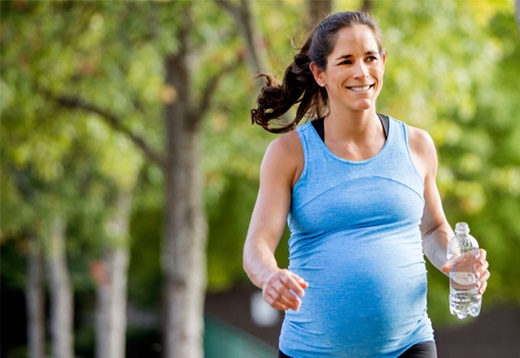3 Myths About Exercise and Pregnancy
As a woman, pregnancy represents one of the greatest physical changes you will ever experience. To support these physical changes and your growing baby, eating healthy is key, but so is staying physically active. But what’s the safest way to exercise during pregnancy ?
A Johns Hopkins maternal-fetal medicine specialist helps debunk common myths about exercise and pregnancy.
Myth #1: If you don’t usually exercise, you shouldn’t start during pregnancy.

This myth has proliferated for many years, but pregnancy is actually an ideal time to start an exercise program — even if you’ve never really exercised before. Public health guidelines for pregnant women recommend moderate exercise or activity for approximately 150 minutes per week (or 30 minutes per day, five days a week). The following are ideal exercises during pregnancy:
- Walking: Walking at a moderate pace can be a great, easy way to fulfill the recommended guidelines. If you’re walking, you should be able to walk and talk at the same time. If you can’t, you should slow down.
- Gym activities: Working out on the elliptical or doing water exercises in the pool are healthy and safe ways to stay active.
- Pilates or yoga: Pilates and yoga can be mentally and physically beneficial. However, hot yoga is not recommended because you should always stay cool and hydrated while pregnant.
The most important thing while performing these exercises is to keep it at a moderate level. Don’t push yourself to the point of exhaustion.
You should be especially careful with exercises that could cause you to lose your balance, since having a fall during pregnancy can be very serious. Riding a bicycle, for example, might not be the safest form of exercise during pregnancy due to the increased fall risk. What’s most important is to find something you enjoy while staying safe. Talk to your doctor to see what works with your personal history.
Myth #2: Athletes can continue vigorous exercise throughout pregnancy without cause for concern.
If you’re a high-performance athlete, you can usually maintain your exercise regimen during pregnancy as long as your pregnancy is uncomplicated. However, you should talk with your health care provider and be more mindful of how you feel while exercising during pregnancy.
Women who are highly athletic may have developed the ability to push through fatigue or cramping. It is important, though, not to push yourself beyond a ‘safe’ threshold, which could affect the fetus. Your physician can provide you with additional guidance to find the right balance.
Myth #3: The only value of exercise during pregnancy is to help you lose weight more easily after your baby is born.
Exercise is a huge component of postpartum weight loss. But the true value of exercise during and after pregnancy is the other incredible health benefits. Your metabolic function is dramatically improved by exercise, and your risk of developing cardiometabolic disease decreases. Even if you don’t see immediate weight loss after pregnancy, you should always continue to exercise because your body is benefiting internally.
According to the U.S. Department of Health and Human Services , regular physical activity is one of the most important things you can do for your health. And that’s just as true during pregnancy.
Sign Up for Our Free Newsletter

One of the best things you can do to protect and improve your health is to stay informed. Your Health is a FREE e-newsletter that serves as your smart, simple connection to the world-class expertise of Johns Hopkins.




